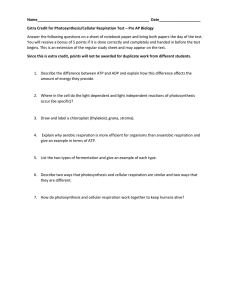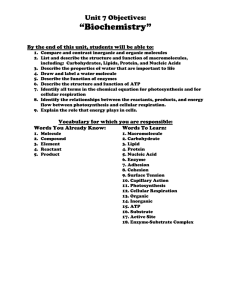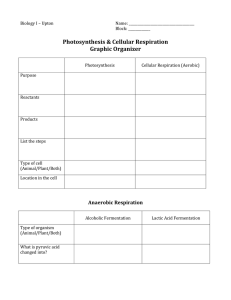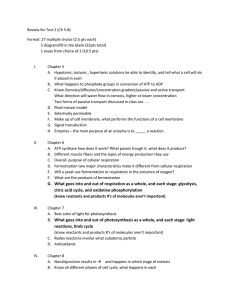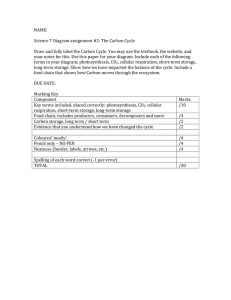WOODLAND HILLS HIGH SCHOOL LESSON PLAN
advertisement
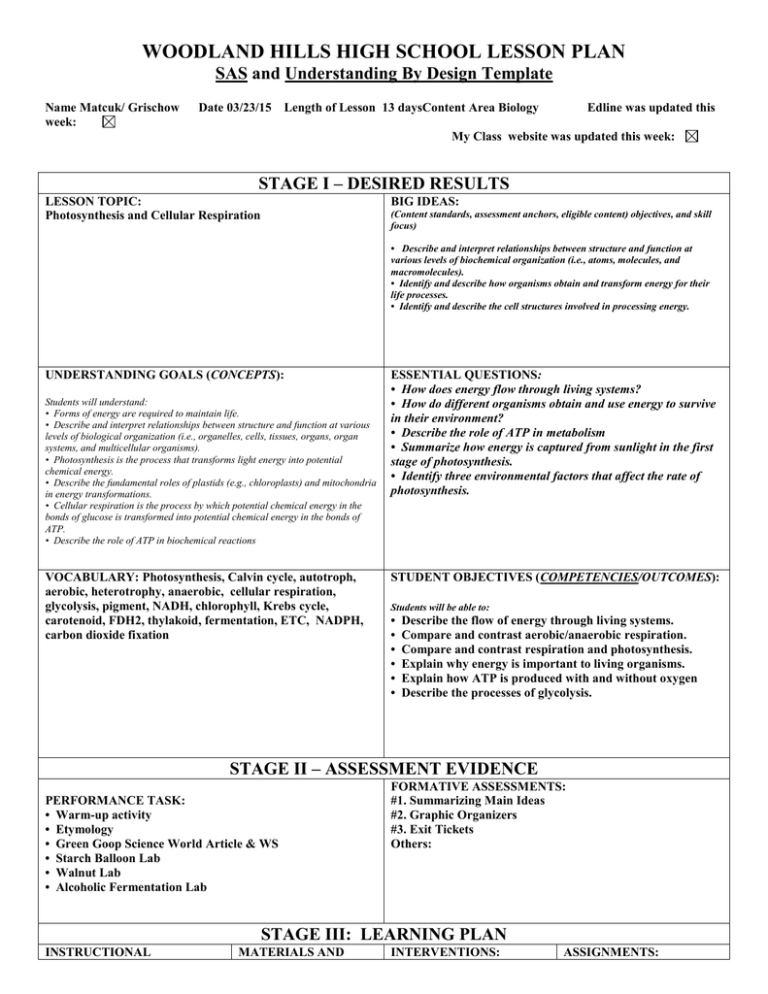
WOODLAND HILLS HIGH SCHOOL LESSON PLAN SAS and Understanding By Design Template Name Matcuk/ Grischow week: Date 03/23/15 Length of Lesson 13 daysContent Area Biology Edline was updated this My Class website was updated this week: STAGE I – DESIRED RESULTS LESSON TOPIC: Photosynthesis and Cellular Respiration BIG IDEAS: (Content standards, assessment anchors, eligible content) objectives, and skill focus) • Describe and interpret relationships between structure and function at various levels of biochemical organization (i.e., atoms, molecules, and macromolecules). • Identify and describe how organisms obtain and transform energy for their life processes. • Identify and describe the cell structures involved in processing energy. UNDERSTANDING GOALS (CONCEPTS): Students will understand: • Forms of energy are required to maintain life. • Describe and interpret relationships between structure and function at various levels of biological organization (i.e., organelles, cells, tissues, organs, organ systems, and multicellular organisms). • Photosynthesis is the process that transforms light energy into potential chemical energy. • Describe the fundamental roles of plastids (e.g., chloroplasts) and mitochondria in energy transformations. • Cellular respiration is the process by which potential chemical energy in the bonds of glucose is transformed into potential chemical energy in the bonds of ATP. • Describe the role of ATP in biochemical reactions VOCABULARY: Photosynthesis, Calvin cycle, autotroph, aerobic, heterotrophy, anaerobic, cellular respiration, glycolysis, pigment, NADH, chlorophyll, Krebs cycle, carotenoid, FDH2, thylakoid, fermentation, ETC, NADPH, carbon dioxide fixation ESSENTIAL QUESTIONS: • How does energy flow through living systems? • How do different organisms obtain and use energy to survive in their environment? • Describe the role of ATP in metabolism • Summarize how energy is captured from sunlight in the first stage of photosynthesis. • Identify three environmental factors that affect the rate of photosynthesis. STUDENT OBJECTIVES (COMPETENCIES/OUTCOMES): Students will be able to: • • • • • • Describe the flow of energy through living systems. Compare and contrast aerobic/anaerobic respiration. Compare and contrast respiration and photosynthesis. Explain why energy is important to living organisms. Explain how ATP is produced with and without oxygen Describe the processes of glycolysis. STAGE II – ASSESSMENT EVIDENCE PERFORMANCE TASK: • Warm-up activity • Etymology • Green Goop Science World Article & WS • Starch Balloon Lab • Walnut Lab • Alcoholic Fermentation Lab FORMATIVE ASSESSMENTS: #1. Summarizing Main Ideas #2. Graphic Organizers #3. Exit Tickets Others: STAGE III: LEARNING PLAN INSTRUCTIONAL MATERIALS AND INTERVENTIONS: ASSIGNMENTS: PROCEDURES: RESOURCES: Active Engagements used: #1. Higher Level Thinking Skills #2. Partnering Others: • Projector • Power Point • Lap top • DVD • Worksheets • Green and red paper • White card stock ovals • Glue sticks, glitter, constuction paper • Scissors •Pipe cleaners Describe usage: • Students will identify the flow of energy through living things and how energy is initially captured from sunlight. • Students will identify factors that affect the rate of photsynthesis. • Students will analyze the function of the electron transport chains in photosynthesis, • Students will relate the Calvin cycle to carbon dioxide fixation. • Students will describe how energy from food is converted to ATP. • Students wll relate the role of the mitochondria to the creation of ATP from food. • Students will summarize how glucose is broken down in the first stage of cellular respiration and identify the role of fermentation in the second stage. • Students will evaluate the importance of oxygen in aerobic respiration Scaffolding used: #1. Build on Prior Knowledge #2 . Provide Visual Support Others: Describe usage: • Students will compare the metabolism of autotrophs and heterotrophs. • The student will build on his knowledge of the organelles of cells and the role they each play in photosynthesis and respiration. • Students will use their knowledge of the differences in the structures of plant and animal cells to explain the differences in the process of metabolism in each type of cell. • Describe how energy is released from ATP for metabolism. Other techniques used: Prompting if necessary. CONTENT AREA READING: Chapter 5 • Student portfolio • Test Corrections • Extended time for homework and tests • Alternative assignments • Tutoring • College Access • Green Goop Science World Article & WS • Photosynthesis Lab • DR 5-1 • DR 5-2 • Leaf Structure Worksheet • Cellular Respiration HW sheet • Starch Balloon Lab • Walnut Lab • Alcoholic Fermentation Lab MINI LESSON: • Photosynthesis Lab • Starch Balloon Lab • Cellular Respiration: Walnut Lab • Alcoholic Fermentation of Fruit Juices Lab • “Built to Swim” Packet

